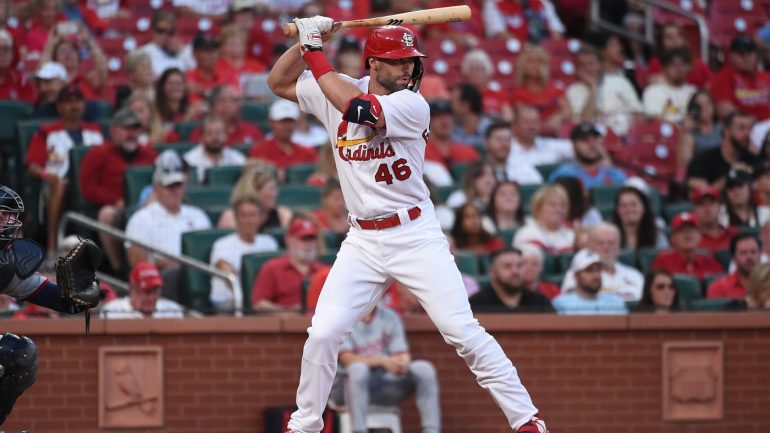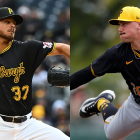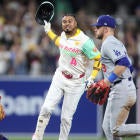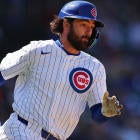
Major League Baseball's postseason is underway with a meatier-than-normal playoff field: 12 teams have gained entrance as part of the expanded postseason that was stipulated in the newest Collective Bargaining Agreement. The top two seeds in each league will receive first-round byes, while the other eight will partake in a best-of-three Wild Card Series to determine who advances to the division round. From there, the postseason will take its usual shape.
Part of the excitement and the unpredictability of the postseason is that the matchups and small details matter more in October than they did during the regular season. After all, a suboptimal draw in June or July may have resulted in a few losses over the course of a long season; in the playoffs, it can be the difference between keeping one's championship hopes alive and beginning one's offseason earlier than planned.
With that in mind, let's highlight one potential x-factor for each of the upcoming Wild Card Series using data you won't find in the box score. Before we get into the good stuff, allow us to preemptively concede that this kind of microanalysis is not perfect in terms of predictive power. Context matters, and so does acknowledging that teams and players can and do make adjustments, particularly when the stakes are this high.
Now, onto the gasbaggery.
1. Phillies vs. Cardinals may come down to the inside game
We're not talking about the mental or spiritual side of things; we're talking about the battle for dominance on the inner half of the plate that could rage between the Phillies' pitchers and the Cardinals' hitters. This series could, in a sense, be determined by a matchup of strength against strength.
During the regular season, the Phillies threw a greater percentage of their pitches on the inner half of the plate than all but one team: the Marlins. Coincidentally, the Cardinals hit inner-half pitches for a better wOBA (a catch-all stat that weighs the run value of walks) than all but one team: the Braves.
To illustrate the Cardinals' dominance on inner-half pitches, consider the following note. There were more than 340 players who had at least 100 plate appearances end on a pitch located on the inner half; the Cardinals had four of the top 21 performers (as judged by wOBA), as well as three additional hitters who performed at a league-average clip or better. Take a look at the pertinent numbers:
| Player | Rank (out of 341) | wOBA (average: .339) |
|---|---|---|
2 | .459 | |
12 | .423 | |
18 | .411 | |
21 | .408 | |
39 | .390 | |
108 | .355 | |
126 | .349 |
On the other side, the Phillies have several key pitchers who rank among those most likely to throw a pitcher to the inner-half. Setup man José Alvarado led the majors in that category (min. 1,000 pitches thrown) while starters Zack Wheeler, Ranger Suárez, and Bailey Falter each rank highly in that respect as well.
That would seem to be an ominous sign for the Phillies, who are likely to start Wheeler and Suárez if the series goes three games. Execution is what matters most in any given game, though, and that's tougher to predict. To wit, Wheeler faced the Cardinals in consecutive starts back in July. His combined totals saw him throw 14 shutout innings in two wins while surrendering nine hits and two walks and striking out 10 batters. The Phillies, no doubt, would love to see Wheeler put up another one of those efforts.
2. Guardians' breaking pitches could break Rays
Where the Phillies and Cardinals series may be dictated by pitch location, the Guardians and Rays series may hinge on pitch selection.
The Rays were the worst-performing of the 12 playoff teams against breaking pitches during the regular season, posting a .259 wOBA. (The next worst club, the Dodgers, checked in 13 points higher.) The Rays were particularly prone to expanding their zone to chase breaking pitches, even if their contact rate was around league average.
The Guardians, it should be noted, don't throw a ton of breaking balls as a rule. They ranked 19th as a staff in that respect. The Who matters more than the Whole here because the Cleveland pitchers who were most likely to throw a breaking pitch were (min. 100 batters faced): Shane Bieber, Nick Sandlin, and Triston McKenzie. Bieber and McKenzie would presumably start two of the three games, if it comes to that.
In other words, the Guardians' rotation would seem particularly well-suited to take advantage of the Rays' lineup, even if that isn't true for the rest of the staff. (Cal Quantrill, the other likely starter, would also rank highly if cutters were regarded as breaking pitches; as it is, he graded as the Guardian least likely to throw a breaker.)
| Pitcher | Breaking ball% | wOBA-against | Whiff rate% |
|---|---|---|---|
Shane Bieber | 46.6% | .220 | 39.9% |
Triston McKenzie | 44.0% | .243 | 35.7% |
Cal Quantrill | 4.2% | .233 | 24.1% |
As for the Rays, the hitters who performed worst against breaking balls this season included David Peralta, Manuel Margot, Taylor Walls, Isaac Paredes, and Harold Ramirez. Conversely, the only Rays likely to be on their Wild Card Series active roster who had a .300 or better wOBA against breaking balls were catcher Christian Bethancourt, infielder Jonathan Aranda, and outfielder Randy Arozarena.
Maybe those individuals can make their opportunities count. Otherwise, the Rays may find it difficult to score while Bieber and McKenzie are in the game, especially if they decide to spam their breaking balls even more often than usual.
3. Mets' Gore could prove inconvenient for Padres
This one is simple. The Mets should have Terrance Gore, the game's preeminent designated pinch-runner, on their roster. They're managed by Buck Showalter, a baseball detective consumed with sniffing out marginal advantages. They're facing an opponent who would seem ill-prepared to stop him, too. Must we write more?
Fine, fine. Baseball Info Solutions keeps track of a variety of times: how long it takes for a pitcher to deliver their offering; how long it takes for the catcher to throw to second base; and how long it takes for the baserunner to steal a base. BIS combines all that information and uses it to assess expected success rates and whether certain runners should have a green, yellow, or red light against certain battery combinations.
Here's Gore's report against the Padres:

Your eyes aren't deceiving you. Gore would seem like a safe bet to run against almost every Padres combination, save those featuring Tim Hill and when/if Josh Hader pitches to Jorge Alfaro.
Choosing when to run isn't quite that easy, and who knows, maybe the Mets don't carry Gore this series. On paper, though, he would seem like a safe bet to swipe a bag in a high-leverage situation.
4. Can the Mariners soar above the Blue Jays?
We opened with an x-factor concerning pitch location, so it's only right for us to end that way, too. As you may have guessed from the subheading, the question here is if the Mariners' pitchers can establish a vertical edge against the Blue Jays' bats.
No pitching staff had a higher percentage of pitches located in the upper half of the zone than the Mariners, who saw more than 47 percent of their pitches wind up there. The Blue Jays' lineup seems well-suited to counter that predilection, as they ranked first in wOBA against pitches located in the upper half of the zone.
Robbie Ray, 5 Consecutive Ks. 🔥 pic.twitter.com/4uRfIOnw9c
— Rob Friedman (@PitchingNinja) July 16, 2022
We've stressed throughout that context is important. Mariners ace Luis Castillo, for example, has not bought into the pitching-up philosophy. He's thrown the lowest percentage of upper-half pitches of any Mariner with 300-plus tosses this year. Contrariwise, the rest of the Mariners rotation -- Robbie Ray, Logan Gilbert, George Kirby, and Marco Gonzales -- has shown a real fondness for elevating.
This series may boil down to those pitchers' abilities to either adjust their approaches or overpower the likes of Teoscar Hernández, Vladimir Guerrero Jr., and George Springer, each of whom posted wOBA of .400 or higher against upper-half pitches. The beauty of the postseason is we won't know which is likelier until it happens.






















